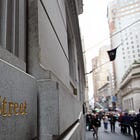Tight Liquidity and Rising Credit Risk Threaten Stock Market Stability
The Navigating The Market Black Friday sale is now live! From now through December 3, you can unlock 20% off your upgrade to any paid tier.
As a free reader, you’ve seen how I track macro trends, liquidity cycles, and volatility patterns. With a paid subscription, you’ll get the full picture:
Premium Monthly – Full access to all premium posts and deep-dive reports each week. Was
$45Now $36Premium Annual – The same complete access, plus additional savings for an annual commitment, the best long-term value. Was
$450Now $360
Advanced Topics – Exclusive coverage of specialized areas like market internals, earnings-driven setups, which comes in one extra commentary per week. Was
$750Now $600
This offer runs through December 3, but the insights you’ll gain will carry well beyond that.
Tight Liquidity and Rising Credit Risk Threaten Stock Market Stability
3 Takeaways
Treasury settlements may pressure equities early in the week as liquidity is raised to meet nearly $60 billion in coupon and bill settlements.
Widening CDS spreads across major tech and AI-linked firms signal increasing credit risk, which may drive multiple contraction and equity weakness.
Tight overnight funding and low reserve balances suggest liquidity will stay constrained, limiting the market’s ability to absorb volatility or new issuance.
Observations
Large Treasury settlements, tightening overnight funding markets, and declining reserve balances are creating significant liquidity pressure that may weigh on equities. Also, widening CDS spreads in AI-exposed names suggest the market is actively repricing risk and setting the stage for potential multiple compression. Together, these dynamics point to tighter liquidity and rising credit risk, fueling further volatility and downside in the near term.
Video
Fully Edited Transcript by ChatGPT
So we’ve been seeing volatility return to the market in recent days and weeks. Much of what we have been discussing going back to July—when the debt ceiling was lifted—has been unfolding, and we’re now seeing those mechanics showing up more clearly. In addition, the recent absence of economic data has allowed the daily impact of volatility and option positioning to exert even greater influence on market movements. The key this week is that several forces are converging: NVIDIA’s results, the return of economic data, and a new round of Treasury settlements.
Last week was a good example of these dynamics coming together. But before going too far into that, please remember to subscribe to this channel, like this video, and share it with your friends. We saw the typical Monday move higher, driven largely by implied volatility ramping up on Friday and collapsing sharply into Monday. On Friday, implied volatility on the VIX reached around 22.5, and by Monday morning it had fallen to 18, grinding lower to 17 by late Tuesday. Then, by Wednesday, volatility began to move higher again.
This sets up a potential problem for Monday morning because we closed around 20, and unless implied volatility is aggressively bid up into Monday’s open, there’s a good chance we see another drop in implied volatility—something we’ve already seen on several recent Mondays. But the broader issue is that Monday, Tuesday, and Thursday are all Treasury settlement dates, which will create overnight funding pressures.
Historically, during settlement periods we tend to see increased usage of the New York Fed’s standing repo facility, with larger settlements driving higher usage. This week, Monday brings $26 billion in coupon settlements, Tuesday brings $14 billion, and Thursday brings another $18 billion. That’s nearly $60 billion of liquidity being drained from the market—an important dynamic. If the market opens higher on Monday, there’s a good chance it gets sold as liquidity is raised for the rest of the week’s settlements. We’ve also seen clear signs of overnight funding pressures.
The idea that the Treasury General Account (TGA) will be drained and inject significant liquidity doesn’t appear accurate. The TGA ended this week at $960 billion. In the recent QRA announcement, Treasury projected a TGA balance of $850 billion by both December and March. That suggests only a modest liquidity release—maybe $100–110 billion—and certainly not a drop to $600 billion. It seems more likely the TGA will hover in the $800–850 billion range.
As of Wednesday, reserve balances were at $2.88 trillion. My estimate for Friday—accounting for reverse repo activity and the TGA—was around $2.8 trillion. These levels are on the low end of the historical range, levels we haven’t seen consistently since early in the pandemic, before the Fed’s large-scale QE expansions. It seems unlikely that the liquidity drained from the market will be fully restored anytime soon. QT remains in place through month-end, continuing to marginally drain liquidity. Other balance sheet liabilities also act against reserve increases, but those tend to move more slowly.
Liquidity is likely to remain tight. On Friday, repo rates were still trading around 3.95%, suggesting SOFR will trade around 3.95–4% on Monday. Once settlements begin, repo rates may move even higher, creating additional pressure as the week starts. Any easing in liquidity seen on Friday will likely fade by midweek, leaving the market under renewed pressure. Even a $100 billion TGA drain isn’t enough to materially lift liquidity from current low levels.
Another emerging issue is rising market skepticism surrounding AI. Oracle’s five-year CDS has risen to around 105–109, levels not seen since the 2022 Fed tightening cycle. JPMorgan’s CDS has ticked up slightly, and CoreWeave’s CDS has climbed to 633—a substantial move. This suggests the market is reassigning risk, viewing heavy AI-related spending as a liability, which implies multiple contraction. Meta’s newly included CDS is at 51—not alarming, but trending in the wrong direction. Historically, widening CDS spreads often correspond with declining equity prices. Meta’s CDS-implied default probability is still very low (3.9% over five years), but after such a large run in the stock, widening spreads raise concerns. These credit dynamics will pressure names like Meta and Oracle.
TradingView offers effective tools for tracking credit spreads, such as the BofA High Yield Option-Adjusted Spread, which has moved higher recently. The MOVE index—bond market volatility—has also widened, which aligns with widening credit spreads and tends to correlate with the S&P 500. Several daily tracking metrics can help assess where the market is headed. One of the more reliable intraday indicators is the SHY/HYG ratio, which aligns well with movements in credit spreads. You can add the ICE BofA credit spread to a chart on a new scale and observe the strong relationship.
For investment-grade credit, using SHY divided by LQD is less precise—it generally tracks, but the alignment isn’t as tight as the high-yield comparison. Still, it can serve as a short-term indicator.
Across the market, there are many reasons for the S&P 500 to continue struggling. Treasury settlements will remain heavy. Issuance isn’t slowing. The reverse repo facility is nearly drained, with only $1.56 billion used on Friday, indicating there’s no excess liquidity left to absorb bill issuance. Liquidity must come from somewhere—money markets, stocks, or other assets. Overnight funding markets make this clear: SOFR-EFFR spreads are widening, as are SOFR-IORB spreads. All of it signals tight liquidity, which is unlikely to ease until the Fed eventually expands its balance sheet again in a meaningful way—a development that’s probably far off.
This setup differs from past pullbacks. There is no excess liquidity buffer, risk is being reassigned due to heavy debt issuance and deteriorating free cash flow in major tech firms, and volatility dispersion trades are unwinding. The dispersion index is falling, three-month correlations are rising, and constituent volatility is declining—all part of the unwind. NVIDIA reports this week, likely the last major catalyst in the dispersion cycle.
We also just experienced historically low levels of realized volatility—levels typically seen only in periods like 2020 or during two specific stretches in 2018. That historically low realized volatility suggests higher volatility ahead. Combined with lower liquidity and falling reserve balances, the setup favors continued downside pressure in the near- to medium-term.
Please remember to subscribe to this channel, like this video, and share it with your friends. I hope to see you again soon. Bye.
Defined Terms and Jargon by ChatGPT
Implied Volatility (IV): A market-derived estimate of future volatility based on options prices.
VIX: The CBOE Volatility Index, measuring implied volatility of S&P 500 options.
Treasury Settlement Date: The day on which buyers of Treasury securities must deliver payment, often creating short-term liquidity demands.
Standing Repo Facility (SRF): A Federal Reserve tool that lends cash overnight against Treasuries to support money market liquidity.
TGA (Treasury General Account): The U.S. Treasury’s cash balance held at the Federal Reserve.
Reserve Balances: Funds that banks hold at the Fed; a key measure of system liquidity.
QT (Quantitative Tightening): The Fed’s process of reducing its balance sheet, draining liquidity from the financial system.
SOFR (Secured Overnight Financing Rate): A measure of cost for overnight borrowing collateralized by Treasuries.
EFFR (Effective Federal Funds Rate): The actual rate at which banks lend reserves to one another overnight.
IORB (Interest on Reserve Balances): Interest paid by the Fed on bank reserves.
CDS (Credit Default Swap): A derivative that measures the market’s perception of default risk for a company or government.
CoreWeave: A cloud computing company heavily associated with AI-related infrastructure spending.
Option-Adjusted Spread (OAS): A measure of credit spread that adjusts for embedded call or put options.
MOVE Index: A measure of expected volatility in the U.S. Treasury market.
SHY/HYG Ratio: A ratio comparing short-term Treasuries (SHY) to high-yield bonds (HYG), often used as a risk-on/risk-off gauge.
LQD: An ETF tracking investment-grade corporate bonds.
Dispersion Trade: A strategy involving volatility differences between an index and its components.
Realized Volatility: The volatility actually observed in the market over a specific period.
Disclaimer
This report contains independent commentary to be used for informational and educational purposes only. Michael Kramer is a member and investment adviser representative with Mott Capital Management. Mr. Kramer is not affiliated with this company and does not serve on the board of any related company that issued this stock. All opinions and analyses presented by Michael Kramer in this analysis or market report are solely Michael Kramer’s views. Readers should not treat any opinion, viewpoint, or prediction expressed by Michael Kramer as a specific solicitation or recommendation to buy or sell a particular security or follow a particular strategy. Michael Kramer’s analyses are based upon information and independent research that he considers reliable, but neither Michael Kramer nor Mott Capital Management guarantees its completeness or accuracy, and it should not be relied upon as such. Michael Kramer is not under any obligation to update or correct any information presented in his analyses. Mr. Kramer’s statements, guidance, and opinions are subject to change without notice. Past performance is not indicative of future results. Neither Michael Kramer nor Mott Capital Management guarantees any specific outcome or profit. You should be aware of the real risk of loss in following any strategy or investment commentary presented in this analysis. Strategies or investments discussed may fluctuate in price or value. Investments or strategies mentioned in this analysis may not be suitable for you. This material does not consider your particular investment objectives, financial situation, or needs and is not intended as a recommendation appropriate for you. You must make an independent decision regarding investments or strategies in this analysis. Upon request, the advisor will provide a list of all recommendations made during the past twelve months. Before acting on information in this analysis, you should consider whether it is suitable for your circumstances and strongly consider seeking advice from your own financial or investment adviser to determine the suitability of any investment.



